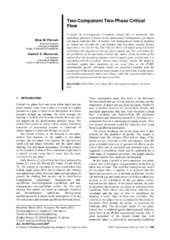Приказ основних података о документу
Kritično dvofazno strujanje dvokomponentne mešavine
Two-component two-phase critical flow
| dc.creator | Petrović, Milan M. | |
| dc.creator | Stevanović, Vladimir | |
| dc.date.accessioned | 2022-09-19T17:57:28Z | |
| dc.date.available | 2022-09-19T17:57:28Z | |
| dc.date.issued | 2016 | |
| dc.identifier.issn | 1451-2092 | |
| dc.identifier.uri | https://machinery.mas.bg.ac.rs/handle/123456789/2379 | |
| dc.description.abstract | U radu je predstavljen model dvokomponentnog dvofaznog kritičnog strujanja dvofazne mešavine. Model je validiran poređenjem računskih rezultata sa vrednostima izmerenim na PUMA eksperimentalnoj instalaciji. Model je zasnovan na jednodimenzionalnom modifikovanom homogenom izentropskom dvofaznom strujanju tečnosti i gasa. Homogeni model je modifikovan tako što je klizanje između faza uzeto u obzir pri određivanju zapreminskog udela gasne faze u dvofaznoj mešavini, što određuje i gustinu dvofazne mešavine. Klizanje između faza je sračunato na osnovu Chisholm korelacije koja je pogodna za niže vrednosti masenog protočnog udela gasne faze kao i na osnovu Zivi korelacije koja određuje maksimalnu vrednost klizanja između faza. Na mestu kritičnog isticanja brzina dvofazne mešavine je jednaka brzini zvuka i sračunata je na osnovu takozvanog zamrznutog modela dvofaznog strujanja koji ne uzima u obzir fazni prelaz. Ostvareni rezultati su prikazani i upoređeni zajedno sa dobro poznatim Fauske modelom dostupnim u literaturi. Pokazano je da Fauske model daje više vrednosti kritičnog masenog fluksa u odnosu na izmerene vrednosti, dok model prikazan u radu daje prihvatljiva slaganja sa izmerenim podacima. | sr |
| dc.description.abstract | A model of two-component two-phase critical flow is presented. The modelling approach is based on one-dimensional homogeneous gas-liquid two-phase isentropic flow of mixture. The homogeneous model is modified by taking into account the void fraction and two-phase mixture density dependence on velocity slip. The velocity slip is calculated using Chisholm correlation that depends on the gas phase quality and Zivi correlation for the prediction of the maximum velocity slip values. At the location of the critical flow the two-phase mixture velocity equals sonic velocity and it is calculated with the so-called ''frozen sonic velocity' model. The model is validated against data measured in air water flow at the PUMA experimental facility. Obtained results are presented together with the predictions by the well-known Fauske model. It is shown that Fauske model overpredicts measured critical mass fluxes, while the present model shows acceptable agreement with the measured data. | en |
| dc.publisher | Univerzitet u Beogradu - Mašinski fakultet, Beograd | |
| dc.relation | info:eu-repo/grantAgreement/MESTD/Basic Research (BR or ON)/174014/RS// | |
| dc.rights | openAccess | |
| dc.rights.uri | https://creativecommons.org/licenses/by/4.0/ | |
| dc.source | FME Transactions | |
| dc.subject | two-phase flow | en |
| dc.subject | homogeneous model | en |
| dc.subject | critical flow | en |
| dc.subject | air-water flow | en |
| dc.title | Kritično dvofazno strujanje dvokomponentne mešavine | sr |
| dc.title | Two-component two-phase critical flow | en |
| dc.type | article | |
| dc.rights.license | BY | |
| dc.citation.epage | 114 | |
| dc.citation.issue | 2 | |
| dc.citation.other | 44(2): 109-114 | |
| dc.citation.rank | M24 | |
| dc.citation.spage | 109 | |
| dc.citation.volume | 44 | |
| dc.identifier.doi | 10.5937/fmet1602109P | |
| dc.identifier.fulltext | http://machinery.mas.bg.ac.rs/bitstream/id/1120/2376.pdf | |
| dc.identifier.scopus | 2-s2.0-84976870651 | |
| dc.type.version | publishedVersion |


